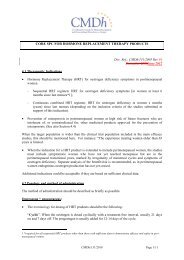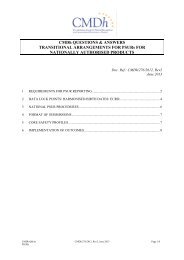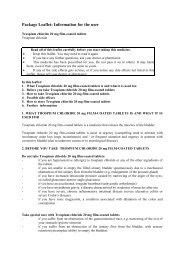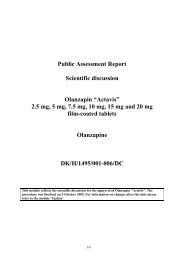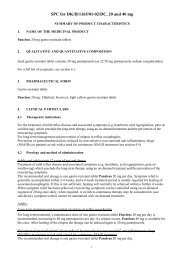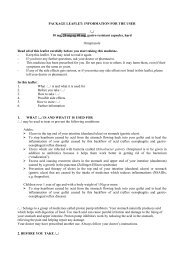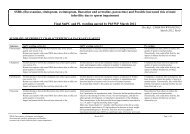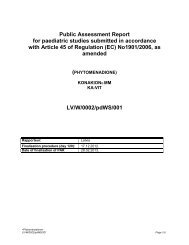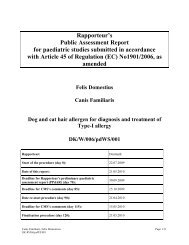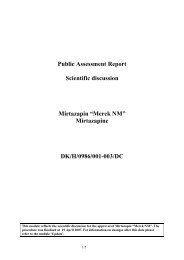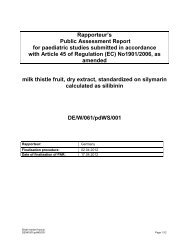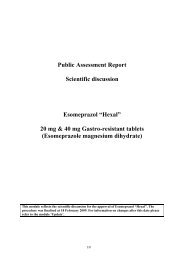Public Assessment Report for paediatric studies submitted in ...
Public Assessment Report for paediatric studies submitted in ...
Public Assessment Report for paediatric studies submitted in ...
Create successful ePaper yourself
Turn your PDF publications into a flip-book with our unique Google optimized e-Paper software.
<strong>Public</strong> <strong>Assessment</strong> <strong>Report</strong><br />
<strong>for</strong> <strong>paediatric</strong> <strong>studies</strong> <strong>submitted</strong> <strong>in</strong> accordance<br />
with Article 45 of Regulation (EC) No1901/2006, as<br />
amended<br />
Rapporteur: AT<br />
Carbomer<br />
Siccapos Gel<br />
Siccapos Gel 2<br />
AT/W/0011/pdWS/001<br />
F<strong>in</strong>alisation procedure (day 120): 03.07.2012<br />
Date of f<strong>in</strong>alisation of PAR 29.08.2012<br />
Carbomer<br />
AT/W/0011/pdWS/001 Page 1/13
TABLE OF CONTENTS<br />
I. Executive Summary ....................................................................................................... 4<br />
II. RecommendatioN .......................................................................................................... 6<br />
III. INTRODUCTION ............................................................................................................. 6<br />
SCIENTIFIC DISCUSSION ......................................................................................................... 8<br />
III.1 In<strong>for</strong>mation on the pharmaceutical <strong>for</strong>mulation used <strong>in</strong> the cl<strong>in</strong>ical study(ies) ......... 8<br />
III.2 Non-cl<strong>in</strong>ical aspects ................................................................................................................... 8<br />
III.3 Cl<strong>in</strong>ical aspects ............................................................................................................................ 8<br />
IV. MEMBER STATES Overall Conclusion AND RECOMMENDATION ........................... 12<br />
V. List of Medic<strong>in</strong>al products and market<strong>in</strong>g authorisation holders <strong>in</strong>volved ............. 13<br />
Carbomer<br />
AT/W/0011/pdWS/001 Page 2/13
ADMINISTRATIVE INFORMATION<br />
Invented name of the medic<strong>in</strong>al<br />
product(s):<br />
INN (or common name) of the active<br />
substance(s):<br />
See section VI<br />
Carbomer<br />
MAH (s): See section VI<br />
Pharmaco-therapeutic group<br />
(ATC Code):<br />
Pharmaceutical <strong>for</strong>m(s) and<br />
strength(s):<br />
S01AX20<br />
eye gel, 2,0 mg/g<br />
Carbomer<br />
AT/W/0011/pdWS/001 Page 3/13
I. EXECUTIVE SUMMARY<br />
Legal background<br />
Art. 45 of Reg. 1901/2006<br />
By January, the 26 th 2008, any <strong>paediatric</strong> <strong>studies</strong> already completed, by the date of entry <strong>in</strong>to<br />
<strong>for</strong>ce, <strong>in</strong> respect of products authorised <strong>in</strong> the Community shall be <strong>submitted</strong> by the market<strong>in</strong>g<br />
authorisation holder <strong>for</strong> assessment to the competent authority.<br />
The competent authority may update the Summary of Product Characteristics and Package<br />
Leaflet, and may vary the market<strong>in</strong>g authorisation accord<strong>in</strong>gly. Competent authorities shall<br />
exchange <strong>in</strong><strong>for</strong>mation regard<strong>in</strong>g the <strong>studies</strong> <strong>submitted</strong> and, as appropriate, their implications <strong>for</strong><br />
any market<strong>in</strong>g authorisations concerned.<br />
The EMA shall coord<strong>in</strong>ate the exchange of <strong>in</strong><strong>for</strong>mation.<br />
As requested by the EMA <strong>in</strong> a letter dated 27 th July 2011 and <strong>in</strong> accordance with Article 45 of<br />
Regulation EC No 1901/2006 as amended, the Market<strong>in</strong>g Authorization Holders <strong>submitted</strong> 5<br />
<strong>studies</strong>/publications.<br />
Background to dry eye<br />
Dry eye is a widespread problem, affect<strong>in</strong>g 0.39% to 33.7% of the population. It can occur <strong>in</strong><br />
association with a number of congenital, autoimmune, endocr<strong>in</strong>e, and <strong>in</strong>flammatory disorders, or<br />
under certa<strong>in</strong> environmental and nutritional conditions.<br />
Dry eye is a chronic condition caused by <strong>in</strong>stability of the tear film cover<strong>in</strong>g the eye; the tear film<br />
breaks up to leave dry spots rather than be<strong>in</strong>g ma<strong>in</strong>ta<strong>in</strong>ed between bl<strong>in</strong>ks. Tears consist of a<br />
slightly alkal<strong>in</strong>e fluid that is spread across the eye by bl<strong>in</strong>k<strong>in</strong>g and is lost via the lachrymal ducts<br />
or by evaporation. Mucus secreted by the conjunctiva is also required to ma<strong>in</strong>ta<strong>in</strong> tear film<br />
stability and dry eye can result from reduced production of either tears or conjunctival mucus.<br />
Reduced tear secretion is common <strong>in</strong> the elderly, but also occurs <strong>in</strong> some systemic disorders or<br />
as an adverse effect of drugs such as those, like tricyclic antidepressants, that have<br />
antimuscar<strong>in</strong>ic effects. Tear film <strong>in</strong>stability may also result from <strong>in</strong>creased tear evaporation, <strong>for</strong><br />
example due to corneal exposure <strong>in</strong> thyroid disease, or from lid, corneal, or other eye disorders.<br />
The ma<strong>in</strong> symptoms of dry eye are discom<strong>for</strong>t, typically with a chronic gritty sensation, visual<br />
disturbances, and sometimes photophobia. If left untreated corneal ulceration and eventual loss<br />
of sight may occur.<br />
Treatment of dry eye is ma<strong>in</strong>ly symptomatic us<strong>in</strong>g 'artificial tears' preparations: eye drops<br />
conta<strong>in</strong><strong>in</strong>g hypromellose or other cellulose ethers (carmellose, hyetellose, methylcellulose),<br />
hydroxypropyl guar gum, polyv<strong>in</strong>yl alcohol, or povidone are used.<br />
M<strong>in</strong>or SmPC and PL changes are proposed <strong>in</strong> section 4.2.<br />
Carbomer<br />
AT/W/0011/pdWS/001 Page 4/13
Summary of outcome<br />
No change<br />
Change<br />
New study data<br />
New safety <strong>in</strong><strong>for</strong>mation<br />
Paediatric <strong>in</strong><strong>for</strong>mation clarified<br />
New <strong>in</strong>dication<br />
Carbomer<br />
AT/W/0011/pdWS/001 Page 5/13
II. RECOMMENDATION<br />
Dry eye symptom does occur <strong>in</strong> the <strong>paediatric</strong> population.<br />
But from the Cl<strong>in</strong>ical Assessor´s po<strong>in</strong>t of view, un<strong>for</strong>tunately based on the data / documentation<br />
provided, no specific recommendation regard<strong>in</strong>g the use of Carbomer <strong>in</strong> the <strong>paediatric</strong><br />
population can be given.<br />
Furthermore, from the Cl<strong>in</strong>ical Assessor´s po<strong>in</strong>t of view, it is not advisable to decidedly suggest a<br />
Non – Use of Carbomer <strong>in</strong> the <strong>paediatric</strong> population due to the lack of data provided, s<strong>in</strong>ce<br />
Carbomer has rather physical properties and thus might be quite suitable to moisten the eye <strong>in</strong><br />
this population, especially <strong>in</strong> a Benzalkonium Chloride free <strong>for</strong>mulation.<br />
Due to the poor data available <strong>for</strong> assessment and <strong>in</strong> the course of discussion with all Member<br />
States follow<strong>in</strong>g word<strong>in</strong>g is considered appropriate to be <strong>in</strong>cluded <strong>in</strong> the SmPC and PIL, as it<br />
does not restrict the use of Carbomer <strong>in</strong> eye drops already licensed <strong>for</strong> use <strong>in</strong> children and<br />
adolescents and also reflects cl<strong>in</strong>ical daily rout<strong>in</strong>e, but still does po<strong>in</strong>t out to the lack of study<br />
data on safety and efficacy:<br />
´The safety and efficacy of XXX <strong>in</strong> children and adolescents at the posology recommended <strong>in</strong><br />
adults has been established by cl<strong>in</strong>ical experience, but no cl<strong>in</strong>ical trial data are available`<br />
As already mentioned above, Carbomer has no pharmacological properties and there<strong>for</strong>e, when<br />
adm<strong>in</strong>istered to the eye <strong>in</strong> children and adolescents, no significant safety issues are anticipated.<br />
Proposed SPC changes<br />
Section 4.2 Posology and method of adm<strong>in</strong>istration<br />
Children and adolescents aged to 18 years:<br />
´The safety and efficacy of XXX <strong>in</strong> children and adolescents at the posology recommended <strong>in</strong><br />
adults has been established by cl<strong>in</strong>ical experience, but no cl<strong>in</strong>ical trial data are available`<br />
Proposed PIL changes:<br />
Section 2 “Take special care with /……./”<br />
Children and adolescents aged to 18 years:<br />
´The safety and efficacy of XXX <strong>in</strong> children and adolescents at the posology recommended <strong>in</strong><br />
adults has been established by cl<strong>in</strong>ical experience, but no cl<strong>in</strong>ical trial data are available`<br />
Section 3<br />
Children and adolescents aged to 18 years:<br />
´The safety and efficacy of XXX <strong>in</strong> children and adolescents at the posology recommended <strong>in</strong><br />
adults has been established by cl<strong>in</strong>ical experience, but no cl<strong>in</strong>ical trial data are available`<br />
III. INTRODUCTION<br />
One MAH (Ursapharm) <strong>submitted</strong> 5 published <strong>paediatric</strong> <strong>studies</strong>/reports <strong>for</strong> carbomer, <strong>in</strong><br />
accordance with Article 45 of the Regulation (EC)No 1901/2006, as amended on medic<strong>in</strong>al<br />
products <strong>for</strong> <strong>paediatric</strong> use.<br />
Carbomer<br />
AT/W/0011/pdWS/001 Page 6/13
A very short critical expert overview has also been provided, but no relevant <strong>in</strong><strong>for</strong>mation could<br />
be obta<strong>in</strong>ed.<br />
The MAH stated that the <strong>submitted</strong> <strong>paediatric</strong> <strong>studies</strong>/reports do not <strong>in</strong>fluence the benefit risk <strong>for</strong><br />
carbomer and that there is no consequential regulatory action.<br />
In addition, the follow<strong>in</strong>g documentation has been <strong>in</strong>cluded:<br />
- A l<strong>in</strong>e list<strong>in</strong>g<br />
Carbomer<br />
AT/W/0011/pdWS/001 Page 7/13
SCIENTIFIC DISCUSSION<br />
III.1 In<strong>for</strong>mation on the pharmaceutical <strong>for</strong>mulation used <strong>in</strong> the cl<strong>in</strong>ical study(ies)<br />
Not applicable<br />
III.2 Non-cl<strong>in</strong>ical aspects<br />
1. Introduction<br />
No non-cl<strong>in</strong>ical <strong>studies</strong> were <strong>submitted</strong>.<br />
2. Non cl<strong>in</strong>ical study(ies)<br />
None<br />
3. Discussion on non cl<strong>in</strong>ical aspects and conclusion<br />
Assessor’s comment:<br />
Not applicable<br />
III.3 Cl<strong>in</strong>ical aspects<br />
1. Introduction<br />
The MAH Ursapharm <strong>submitted</strong> 2 published <strong>studies</strong>/reports <strong>for</strong>:<br />
1. "Keratoconjunctivitis sicca <strong>in</strong> juvenile rheumatoid arthritis."<br />
Ak<strong>in</strong>ci, A.; Cakar, N.; Uncu, N.; Kara, N.; Acaroglu, G.<br />
Cornea 2007; 26: 941<br />
2. "Dry eye <strong>in</strong> pediatric contact lens wearers."<br />
Gre<strong>in</strong>er, K. L.; Wall<strong>in</strong>e, J. J.<br />
Eye & Contact Lens 2010; 36: 352<br />
The MAH Ursapharm <strong>submitted</strong> 3 literature references = publications <strong>for</strong>:<br />
1. "Dry eye <strong>in</strong> childhood: epidemiological and cl<strong>in</strong>ical aspects."<br />
Alves, M.; Dias, A. C.; Rocha, E. M.<br />
Ocul Surf 2008; 6: 44<br />
2. "Dry eye syndrome and neurotrophic keratitis <strong>in</strong> childhood. ."<br />
Dietrich, T.; Renner, A. B.; Helbig, H.; Oberacher-Velten, I. M.<br />
Ophthalmologe 2010; 107: 911<br />
3. "Augenerkrankungen im K<strong>in</strong>desalter".<br />
Küchle, H. J.; Busse, H.<br />
Georg Thieme Verlag, Stuttgart/New York 1985.<br />
Carbomer<br />
AT/W/0011/pdWS/001 Page 8/13
2. Cl<strong>in</strong>ical <strong>studies</strong><br />
A) published cl<strong>in</strong>ical <strong>studies</strong><br />
1. "Keratoconjunctivitis sicca <strong>in</strong> juvenile rheumatoid arthritis."<br />
Ak<strong>in</strong>ci, A.; Cakar, N.; Uncu, N.; Kara, N.; Acaroglu, G.<br />
Cornea 2007; 26: 941<br />
� Methods<br />
• Objective(s)<br />
To compare the symptoms, signs, and results of objective tests <strong>for</strong> keratoconjunctivitis sicca<br />
(KCS) <strong>in</strong> patients with juvenile rheumatoid arthritis (JRA) and controls.<br />
• Study design<br />
Prospective study. JRA group + Control Group<br />
• Study population /Sample size<br />
Seventy-six patients with JRA were exam<strong>in</strong>ed. Twelve patients receiv<strong>in</strong>g glucocorticoids were<br />
excluded due to glucocorticoids <strong>in</strong>take, thus 64 patients with JRA were <strong>in</strong>cluded. 38 boys + 26<br />
girls <strong>in</strong> both groups. The mean age was 13.2 ± 3.1 (SD) years (range, 8-17 years) <strong>in</strong> the JRA<br />
group and 13.4 ± 3.3 years (range, 8-17 years) <strong>in</strong> the control group.<br />
(Exclusion criteria: <strong>for</strong> both groups consisted of receiv<strong>in</strong>g glucocorticoids or antihistam<strong>in</strong>es<br />
because these drugs are known to affect tear secretion, 5 presence of any other systemic<br />
disease, use of an ocular topical treatment with<strong>in</strong> the last 6 months, and previous ocular laser or<br />
surgical treatment.<br />
• Outcomes/endpo<strong>in</strong>ts<br />
Relation between tear film breakup time (TBUT), Schirmer test results, and JRA-related variables<br />
such as age of onset, duration, and type of JRA; presence of ant<strong>in</strong>uclear antibodies (ANAs); and<br />
history of uveitis were evaluated.<br />
• Statistical Methods<br />
Analysis of variance, multivariate regression analysis, Kruskall-Wallis, Student t tests, and X2<br />
tests were used <strong>for</strong> statistical analysis.<br />
� Results<br />
• Among 64 children with JRA, 32 had the pauciarticular, 22 had the polyarticular, and 10 had the<br />
systemic <strong>for</strong>m of disease. ANA was positive <strong>in</strong> 24 (37.5%), and previous uveitis was detected <strong>in</strong><br />
15 (23.4%) children. The mean age of onset and duration of JRA were 6.1 ± 3.4 (range, 5-12) and<br />
6.8 ± 2.8 years (range, 4-13 years), respectively.<br />
Dry eye signs were detected <strong>in</strong> 7 children (10.9%) <strong>in</strong> the JRA group and <strong>in</strong> 1 child (1.5%) <strong>in</strong> the<br />
control group; there<strong>for</strong>e, the prevalence of dry eye signs was significantly higher <strong>in</strong> the JRA group<br />
(X2 test, P = 0.038).<br />
Among 64 children with JRA, 38 were boys and 26 were girls. TB UT and Schirmer test results<br />
were significantly lower <strong>in</strong> boys (Student t test, P = 0.023 and P 0.018, respectively).<br />
7 (10.9%) of the 64 children with JRA had a def<strong>in</strong>ite diagnosis and 1 (1.5%) of 64 had a probable<br />
diagnosis of KCS.<br />
Among patients with JRA, boys and ones with longer duration of disease are more prone to have<br />
lower basal tear secretion and tear-film stability.<br />
Carbomer<br />
AT/W/0011/pdWS/001 Page 9/13
Assessor’s comment:<br />
Although this study shows, that dry eyes symptoms are associated with JRA <strong>in</strong> children, no <strong>in</strong><strong>for</strong>mation<br />
regard<strong>in</strong>g the symptomatic treatment of dry eyes with Carbomer can be obta<strong>in</strong>ed, there<strong>for</strong>e no relevant<br />
<strong>in</strong><strong>for</strong>mation or recommendation regard<strong>in</strong>g the use of Carbomer <strong>in</strong> children can be given.<br />
2. "Dry eye <strong>in</strong> pediatric contact lens wearers."<br />
Gre<strong>in</strong>er, K. L.; Wall<strong>in</strong>e, J. J.<br />
Eye & Contact Lens 2010; 36: 352<br />
� Methods<br />
• Objective(s)<br />
To determ<strong>in</strong>e whether children who wear contact lenses truly have fewer dry eye compla<strong>in</strong>ts than<br />
adults do.<br />
• Study design<br />
N<strong>in</strong>ety-four pediatric contact lens wearers aged 8 to 14 years, were recruited from pediatric<br />
contact lens <strong>studies</strong> conducted at both The Ohio State University College of Optometry and New<br />
England College of Optometry and given the Contact Lens Dry Eye Questionnaire (CLDEQ) short<br />
<strong>for</strong>m. All of the subjects wore either 1 Day Acuvue or Acuvue Advance contact lenses (Vistakon;<br />
Jacksonville, FL). and all subjects wore contact lenses <strong>for</strong> at least 3 months. The Acuvue Advance<br />
contact lens wearers were all provided with Opti-Free Replenish multipurpose contact lens<br />
solutions.<br />
CLDEQ: Subjects categorize the frequency of each symptom coded as 1, never; 2, <strong>in</strong>frequently; 3,<br />
occasionally; 4, frequently; and 5 constantly.<br />
• Study population / Sample size<br />
N<strong>in</strong>ety-four pediatric contact lens wearers aged 8 to 14 years. The average (±SD) age of the<br />
sample was 11.7 ±. 1.5 years, 56.4% were female, 59.6% were white, and 19.1% were black<br />
• Outcomes/endpo<strong>in</strong>ts<br />
CLDEQ: Subjects categorize the frequency of each symptom coded as 1, never; 2, <strong>in</strong>frequently; 3,<br />
occasionally; 4, frequently; and 5 constantly. If the subject classifies the symptom as <strong>in</strong>frequent to<br />
constant, he or she then categorizes the <strong>in</strong>tensity of the symptom with<strong>in</strong> the first 2 hr of <strong>in</strong>sert<strong>in</strong>g<br />
the lenses, <strong>in</strong> the middle of the day, and at the end of the day. Intensity is ranked on a scale of 1<br />
to 5, where 1 is not at all <strong>in</strong>tense, and 5 is very <strong>in</strong>tense.<br />
• Statistical Methods<br />
� Results<br />
• The average (±SD) age of the sample was 11.7 ± 1.5 years, 56.4% were female, 59.6% were<br />
white, and 19.1% were black. The mean (±SD) CLDEQ composite score was 0.25 ± 0.50 (range=<br />
-1.20 to 1.45). In the literature, the adult mean (±SD) CLDEQ composite score was 1.02 ± 0.80<br />
(range = -0.74 to 4.50). Of the 94 surveys collected, 4.3% of children were categorized as hav<strong>in</strong>g<br />
dry eye compared with 56.2% of the adults who completed the CLDEQ survey <strong>in</strong> the adult study.<br />
• Conclusion: Pediatric contact lens wearers have fewer compla<strong>in</strong>ts about dry eyes than do adult<br />
contact lens wearers, which may be because of improved tear film, differences <strong>in</strong> report<strong>in</strong>g of<br />
symptoms, or modality of contact lens wear.<br />
Carbomer<br />
AT/W/0011/pdWS/001 Page 10/13
Assessor’s comment:<br />
No <strong>in</strong><strong>for</strong>mation about Carbomer can be obta<strong>in</strong>ed from this paper. There<strong>for</strong>e no evaluable <strong>in</strong><strong>for</strong>mation<br />
regard<strong>in</strong>g safety, efficacy and posology can be drawn from this publication.<br />
B) literature references = publications<br />
1. "Dry eye <strong>in</strong> childhood: epidemiological and cl<strong>in</strong>ical aspects."<br />
Alves, M.; Dias, A. C.; Rocha, E. M.<br />
Ocul Surf 2008; 6: 44<br />
This paper provides an overview about the possible causes of dry eye <strong>in</strong> childhood.<br />
Dry eye can occur <strong>in</strong> association with a number of congenital, autoimmune, endocr<strong>in</strong>e, and <strong>in</strong>flammatory<br />
disorders, or under certa<strong>in</strong> environmental and nutritional conditions.<br />
Assessor`s comment:<br />
No <strong>in</strong><strong>for</strong>mation about Carbomer can be obta<strong>in</strong>ed from this paper. There<strong>for</strong>e no evaluable <strong>in</strong><strong>for</strong>mation<br />
regard<strong>in</strong>g safety, efficacy and posology can be drawn from this publication.<br />
2. "Dry eye syndrome and neurotrophic keratitis <strong>in</strong> childhood."<br />
Dietrich, T.; Renner, A. B.; Helbig, H.; Oberacher-Velten, I. M.<br />
Ophthalmologe 2010; 107: 911<br />
This reference is a literature overview of the pathogenesis of dry eye syndrome and neurotrophic keratitis.<br />
Cl<strong>in</strong>ical cases from <strong>paediatric</strong> ophthalmology office are presented as well as therapeutic strategies.<br />
Assessor`s comment:<br />
No <strong>in</strong><strong>for</strong>mation about Carbomer can be obta<strong>in</strong>ed from this paper. There<strong>for</strong>e no evaluable <strong>in</strong><strong>for</strong>mation<br />
regard<strong>in</strong>g safety, efficacy and posology can be drawn from this publication.<br />
3. "Augenerkrankungen im K<strong>in</strong>desalter".<br />
Küchle, H. J.; Busse, H.<br />
Georg Thieme Verlag, Stuttgart/New York 1985.<br />
This is an abstract from a book <strong>in</strong> German language about eye diseases <strong>in</strong> children. Un<strong>for</strong>tunately the<br />
relevant pages about diseases of the lacrimal apparatus are miss<strong>in</strong>g.<br />
Assessor`s comment:<br />
No conclusion about Carbomer regard<strong>in</strong>g safety, efficacy and posology can be drawn from this<br />
publication.<br />
Carbomer<br />
AT/W/0011/pdWS/001 Page 11/13
IV. MEMBER STATES OVERALL CONCLUSION AND<br />
RECOMMENDATION<br />
� Overall conclusion<br />
Dry eye symptom does occur <strong>in</strong> the <strong>paediatric</strong> population.<br />
But from the Cl<strong>in</strong>ical Assessor´s po<strong>in</strong>t of view, un<strong>for</strong>tunately based on the data / documentation<br />
provided, no specific recommendation regard<strong>in</strong>g the use of Carbomer <strong>in</strong> the <strong>paediatric</strong><br />
population can be given.<br />
Furthermore, from the Cl<strong>in</strong>ical Assessor´s po<strong>in</strong>t of view, it is not advisable to decidedly suggest a<br />
Non – Use of Carbomer <strong>in</strong> the <strong>paediatric</strong> population due to the lack of data provided, s<strong>in</strong>ce<br />
Carbomer has rather physical properties and thus might be quite suitable to moisten the eye <strong>in</strong><br />
this population, especially <strong>in</strong> a Benzalkonium Chloride free <strong>for</strong>mulation.<br />
Due to the poor data available <strong>for</strong> assessment and <strong>in</strong> the course of discussion with all Member<br />
States follow<strong>in</strong>g word<strong>in</strong>g is considered appropriate to be <strong>in</strong>cluded <strong>in</strong> the SmPC and PiL, as it<br />
does not restrict the use of Carbomer <strong>in</strong> eye drops already licensed <strong>for</strong> use <strong>in</strong> children and<br />
adolescents and also reflects cl<strong>in</strong>ical daily rout<strong>in</strong>e, but still does po<strong>in</strong>t out to the lack of study<br />
data on safety and efficacy:<br />
´The safety and efficacy of XXX <strong>in</strong> children and adolescents at the posology recommended <strong>in</strong><br />
adults has been established by cl<strong>in</strong>ical experience, but no cl<strong>in</strong>ical trial data are available`<br />
As already mentioned above, Carbomer has no pharmacological properties and there<strong>for</strong>e, when<br />
adm<strong>in</strong>istered to the eye <strong>in</strong> children and adolescents, no significant safety issues are anticipated.<br />
� Recommendation<br />
Proposed SPC changes<br />
Section 4.2 Posology and method of adm<strong>in</strong>istration<br />
Children and adolescents aged to 18 years:<br />
´The safety and efficacy of XXX <strong>in</strong> children and adolescents at the posology recommended <strong>in</strong><br />
adults has been established by cl<strong>in</strong>ical experience, but no cl<strong>in</strong>ical trial data are available`<br />
Proposed PIL changes:<br />
Section 2 “Take special care with /……./”<br />
Children and adolescents aged to 18 years:<br />
´The safety and efficacy of XXX <strong>in</strong> children and adolescents at the posology recommended <strong>in</strong><br />
adults has been established by cl<strong>in</strong>ical experience, but no cl<strong>in</strong>ical trial data are available`<br />
Section 3<br />
Children and adolescents aged to 18 years:<br />
´The safety and efficacy of XXX <strong>in</strong> children and adolescents at the posology recommended <strong>in</strong><br />
adults has been established by cl<strong>in</strong>ical experience, but no cl<strong>in</strong>ical trial data are available`<br />
Carbomer<br />
AT/W/0011/pdWS/001 Page 12/13
V. LIST OF MEDICINAL PRODUCTS AND MARKETING<br />
AUTHORISATION HOLDERS INVOLVED<br />
URSAPHARM<br />
Arzneimittel GmbH<br />
URSAPHARM<br />
Arzneimittel GmbH<br />
Siccapos Gel 2,0 mg/g eye gel<br />
Siccapos Gel 2 2,0 mg/g eye gel<br />
Carbomer<br />
AT/W/0011/pdWS/001 Page 13/13



